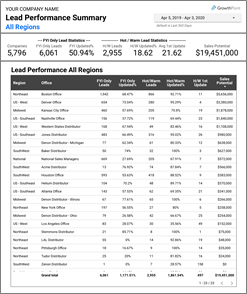There are many ways that marketing and sales go about measuring their efforts for their own purpose. You have marketing waterfall reports. You have sales forecast reports. You have sales activity reports. You have marketing media metrics. But what about the kind of report that sales and marketing should share together and talk about the most? Which reporting creates the right marketing-sales conversation about leads?
Two reports that ask/answer the right questions for a conversation
While some of the measurements above are siloed in either marketing or sales, there is one particular measurement conversation that brings focus to the top of the funnel. Marketing and sales can work together at the top of the funnel to shape the demand and create the demand that is essential to refilling the sales pipeline with leads that are more than just a response to an RFP or RFQ (where sales has little influence other than price and availability). The real opportunity is in building the early relationships where sales can influence what people want to buy. To do this, you first need to create measurement tools that help you answer these questions:
- Is marketing identifying the right kinds of leads?
- Is marketing effectively grading/delivering these leads to sales?
- Is sales being accountable to work these leads?
- Is sales providing the feedback marketing needs to improve?
- What revenue are WE generating from our marketing investment?
Helpful Resource: Download our white paper, “Defining and Delivering B2B Leads that Sales People Want,” where we examine how marketing and sales define leads.
Effective marketing summary
For the marketing side, you should have a single dashboard (Figure 1) that provides insight into campaign results and lead quality. The top report on this dashboard:
- Lists each type of marketing sourced campaign
- Lists the totals for each type of lead (in this case FYI Only and Warm and Hot leads)
- The follow-up effort (by percentage) of sales for each type of lead
- The average 1st update response (in days) for Warm and Hot leads
- The sales potential identified (converted to opportunities)
Figure 1 – Marketing Dashboard
This particular report gives marketing the feedback required to sit down and have a conversation with sales about accountability of sales follow-up. Sales management can then refer to their sales report (next section) to examine performance by region/office, or drill down to each salesperson to create conversations about lead follow-up (1st update time for hot/warm leads, or overall lead follow-up).
The second report (Sales Rejected Leads) provides the mechanism where sales is giving feedback to marketing about the leads that are rejecting as “not good leads.” Sales can hold marketing accountable for improving the leads. Marketing can take this feedback, for example in this report the significant number of leads that are “not a fit” and research which tactics are generating these types of leads and why.
Effective sales summary
Likewise, if sales management only measures tasks, activities, and dollars associated with opportunity progress closely and does not have a simple lead summary dashboard like Figure 2, then you are only focused on ONE end of your sales pipeline. You are not creating meaningful conversation around the follow-up and qualification of marketing qualified leads – which is essential to keep filling your opportunity pipeline.
This one basic report (with the scoreboard types totals at the top) gives sales management a view of each region and office lead follow-up performance in the key categories of:
- What percentage of leads are being worked?
- How quickly are Hot & Warm leads getting a response? (remember the stat from insidesales.com – 50% of the wins go to the company that responds FIRST)
- Where are we generating sales potential?
Figure 2 – Sales Lead Performance Summary

Sales management can have meaningful conversations with their channel partners, sales leaders, and individuals to review and improve the lead follow-up activities that will ultimately generate more opportunities.
You can count on sales to always ask for “sales ready” leads. That’s a given. However, if they were all “sales ready” you would just hire people to take orders. The real job of sales is to recognize when marketing provides good leads that turn into meaningful prospect relationships with the right companies and the right contacts – and to make sure to objectively give feedback to marketing so they can deliver MORE of these leads. High performing sales reps know that cultivating these relationships will deliver results in filling the sales pipeline.
Create These Reports Now
I have rarely seen an organization that needed more reports. However, I have often encountered organizations that don’t have the right reports to generate proactive and results-driven conversations.
These two simple dashboards bring sales and marketing together to talk and greatly improve the results of marketing investments and build common accountability for both marketing and sales around leads. Are you having those conversations today based on real data, or just what people are saying anecdotally?
The examples provided here are real, live dashboards that have been altered to reflect a sample company. In fact, these are Google Data Studio dashboards, which is a free tool. The key is identifying and creating the right data sources, and possibly adding a few fields to those sources, so that you can combine your silos of data and create your own dashboards.
If you don’t want to wait to figure out who can do this inside your organization, give us a call. Let’s talk about we can deliver the dashboards that will create the meaningful conversations you need to have to align marketing and sales and increase your success.







